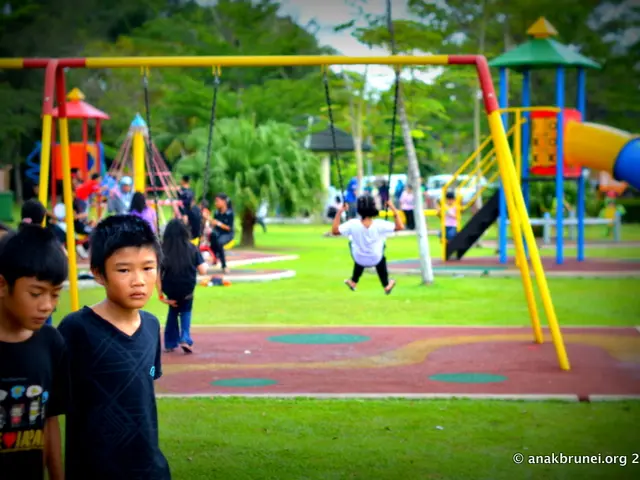Do Neural Connections Develop Anew During the Learning Process? Insights on Neuroplasticity and Neurogenesis
Title: Wired Differently: Exploring Neural Plasticity and Neurogenesis
Introduction: 🧠 Mind-blowing! Your brain doesn't just follow a set of instructions; it's constantly evolving! In this post, we're going to dive deep into the concept of neuroplasticity, learning about the incredible process of forming new neural connections as you learn new things. Buckle up, as we delve into how your brain gets wired differently with each bite of knowledge.
The Roadmap to Change: 🧮 Here's a quick summary of terms we’ll encounter:
- Plasticity: The brain's ability to change its structure and connections based on experiences and learning.
- Neuroplasticity: Specifically, the brain's ability to form new neural connections, rearrange existing ones, and even grow new neurons.
- Neurogenesis: The creation of new brain cells (neurons) during adulthood. Especially important in areas related to learning and memory, such as the hippocampus.
- Synapse: A junction between 2 neurons where electro-chemical signals are transmitted.
Welcome to Plasticity Town: 🎡 Neuroplasticity is the ultimate theme park where your brain learns new tricks every day. As you go about learning new facts, skills, or behaviors, your brain remolds itself to accommodate these changes. Learning involves gaining new synapses, strengthening existing connections, or even losing synapses that aren't frequently used.
The Power of Creation: 🚀 New brain cells? Way cool! Contrary to what you may have heard, your brain can actually generate new neurons in certain brain areas, a process known as neurogenesis. This phenomenon is most commonly seen in the hippocampus, playing a key role in learning and memory.
Fake News? Well...Kinda: 🧑🦰 New neurons? Debatable! A bunch of smart cookie researchers have their theories. Some claim that new neurons are indeed created in the adult human brain, while others argue for alternative explanations. To add fuel to the fire, the method used to detect new neurons, such as the radioactive carbon-dating, has faced some controversy. In a nutshell, we won't be 100% sure about the degree of adult human neurogenesis until more research is conducted.
The Plasticity Party: 🎉 Here's where things get interesting – we know beyond a shadow of a doubt that the brain forms new connections during the learning process, and that these changes persist throughout adulthood. From hiking to learning a new language, these experiences lead to brain restructuring, amplifying the wonder that is neuroplasticity!
Why Grow New Brain Cells? 💭 Now you're thinking! We don't know exactly why our brain decides to grow new cells, but one theory suggests that these new neurons act as backup, ensuring the learning process can continue smoothly. Another idea is that they come in handy when we need to master new skills or retain information.
The Neuroplasticity Timescale: 🕛 Learning can take time, with brain changes occurring over weeks and even months. For new synapses to solidify, it might take up to 15 hours! That's why taking a break after learning gives your mind's sweet, sweet time to process that knowledge.
Exercising That Brain: 🏋️♂️ You already know that physical exercise is super-duper important for maintaining muscle health. But have you ever wondered how it might tweak your brain's wiring too? Well, it turns out exercise also stimulates the formation of new neural connections in the hippocampus, which is great news for both brains and bodies!
Study Up: 📚 Brush up on your linguistic skills, play a musical instrument, or devour that new novel! Learning a new language generates large-scale changes in the brain, expanding language-related regions. Musical training even helps fight off cognitive decline in old age, thanks to synaptic plasticity and neurogenesis.
Clusters of Genesis: 💧 Researchers have discovered that when learning a new task, new clusters of neurons are formed! These clusters persist even after the learning is discontinued. Daily learning and practice help these new connections become more robust and efficient.
Here's the TLDR: ❌❌❌ Brain wiring changes during learning; new neural connections are formed throughout adulthood ✅✅✅ New cells (neurogenesis) are still under study but we know brain changes persist during learning
References:
- https://www.frontiersin.org/articles/10.3389/fncel.2019.00066/full
- http://teachline.ls.huji.ac.il/72336/sphira/kandel-review.pdf
- https://www.sciencedirect.com/science/article/abs/pii/S0166223614001544
- http://www.huffingtonpost.com/entry/neurogenesis-how-to-grow-new-brain-cells_us_56253c16e4b0bce347019a2c?section=india
- http://www.nature.com/nm/journal/v4/n11/full/nm1198_1313.html
- The brain's constant evolution through neuroplasticity can impact various aspects of mental health, such as emotion, sleep, depression, and anxiety.
- Research in health-and-wellness and mental-health fields can provide evidence-based strategies for managing mental health issues, enhancing cognitive processes like learning, memory, and productivity, and improving overall brain function.
- Understanding neuroplasticity and its role in learning can help us develop better habits for education-and-self-development, ultimately leading to a healthier and more productive life.
- Synaptic plasticity, the strengthening or weakening of synapses in response to behavior and experiences, plays a crucial role in the learning process and is affected by various mental states, including memories, emotions, and even psychological disorders like depression and anxiety.
- Studies show that neuroplasticity is not limited to childhood but continues throughout adulthood, allowing for significant changes in our brain wiring and behavior based on our experiences, learning, and mental health.
- Therapy techniques based on neuroplasticity principles, such as cognitive-behavioral therapy, can help people change their thoughts, emotions, and behaviors to improve their mental health and overall well-being.
- The process of neurogenesis, the creation of new brain cells during adulthood, is still a subject of debate among researchers, but it is important to note that evidence suggests new brain cells can be generated, especially in areas related to learning and memory, like the hippocampus.
- Incorporating learning and mental health practices that promote neuroplasticity and neurogenesis, such as exercise, hobbies, and meditation, can help improve overall brain health and cognitive function.
- Learning a new language or skill can lead to significant changes in the brain's structure and function, boosting cognitive abilities and creating long-lasting neural connections that positively impact memory, attention, and problem-solving skills.
- Science continues to unravel the mysteries of the brain, and research in psychology, neuroscience, and education-and-self-development will help us better understand the brain's potential for change and the ways we can optimize our mental health and cognitive abilities throughout our lives.







